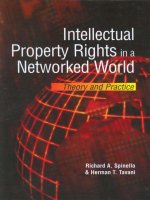Entrepreneurship theory process practice 8e by kuratko 8e ch 07
Bạn đang xem bản rút gọn của tài liệu. Xem và tải ngay bản đầy đủ của tài liệu tại đây (620.17 KB, 43 trang )
Part II
Initiating Entrepreneurial
Ventures
CHAPTER
7
Legal
Challenges for
Entrepreneurial
Ventures
© 2009 South-Western, a part of Cengage Learning.
All rights reserved.
PowerPoint
PowerPoint Presentation
Presentation by
by Charlie
Charlie Cook
Cook
The
The University
University of
of West
West Alabama
Alabama
Chapter Objectives
1.
To introduce the importance of legal issues to
entrepreneurs
2.
To examine patent protection, including definitions
and preparation
3.
To review copyrights and their relevance to
entrepreneurs
4.
To study trademarks and their impact on new
ventures
5.
To examine the legal forms of organization—sole
proprietorship, partnership, and corporation
6.
To illustrate the advantages and disadvantages of
each of these three legal forms
© 2009 South-Western, a part of
Cengage Learning. All rights reserved.
7–2
Chapter Objectives (cont’d)
7.
To explain the nature of the limited partnership
and limited liability partnerships (LLPs)
8.
To examine how an S corporation works
9.
To define the additional classifications of
corporations, including limited liability
companies (LLCs)
10. To present the major segments of the
bankruptcy law that apply to entrepreneurs
© 2009 South-Western, a part of
Cengage Learning. All rights reserved.
7–3
Legal Challenges for
the Entrepreneurial Venture
Inception
Inceptionof
ofthe
the
Venture
Venture
The
The Ongoing
Ongoing
Venture
Venture
Legal
Legal
Concepts
Concepts
Growth
Growthand
and
Continuity
Continuityof
of the
the
Venture
Venture
© 2009 South-Western, a part of
Cengage Learning. All rights reserved.
7–4
Major Legal Concepts and Entrepreneurial Ventures
• I. Inception of an Entrepreneurial Venture
A. Laws governing intellectual property
• 1. Patents
• 2. Copyrights
• 3. Trademarks
B. Forms of business organization
•
•
•
•
1. Sole proprietorship
2. Partnership
3. Corporation
4. Franchise
C. Tax considerations
D. Capital formation
E. Liability questions
© 2009 South-Western, a part of
Cengage Learning. All rights reserved.
7–5
Major Legal Concepts and Entrepreneurial Ventures
• II. Ongoing Venture: Business Development and
Transactions
A. Personnel Law
•
•
•
1. Hiring and firing policies
2. Equal Employment Opportunity Commission
3. Collective bargaining
B. Contract Law
•
•
•
1. Legal contracts
2. Sales contracts
3. Leases
© 2009 South-Western, a part of
Cengage Learning. All rights reserved.
7–6
Major Legal Concepts and Entrepreneurial Ventures
• III. Growth and Continuity of an Entrepreneurial
Venture
A. Tax considerations
•
•
•
B. Governmental regulations
•
•
•
1. Federal, state, and local
2. Payroll
3. Incentives
1. Zoning (property)
2. Administrative agencies (regulatory)
3. Consumer law
C. Continuity of ownership rights
• 1. Property laws and ownership
• 2. Wills, trusts, and ownership
• 3. Bankruptcy
© 2009 South-Western, a part of
Cengage Learning. All rights reserved.
7–7
Intellectual Property Protection: Patents
• Patent
Provides the owner with exclusive rights to hold,
transfer, and license the production and sale of the
product or process as an intellectual property right.
Design patents last for 14 years; all others last for 20
years.
• What Items Qualify for Patent Protection?
Processes, machines, products, plants, compositions
of elements (chemical compounds), and
improvements on already existing items.
© 2009 South-Western, a part of
Cengage Learning. All rights reserved.
7–8
Securing a Patent
• Rule 1: Pursue patents that are broad, are
commercially significant, and offer a
strong position.
• Rule 2: Prepare a patent plan in detail.
• Rule 3: Have your actions relate to your
original
patent plan.
• Rule 4: Establish an infringement budget.
• Rule 5: Evaluate the patent plan
strategically.
© 2009 South-Western, a part of
Cengage Learning. All rights reserved.
7–9
Intellectual Property Protection: Patents
•
Patent Application
1.
Specification: the text of a patent and may include
any accompanying illustrations.
a.
b.
c.
An introduction explaining why the invention will be useful.
A description of prior art considered similar to the invention.
A summary of the essence of the technology/invention, its
differences from prior art and requisite features.
d. A description of the invention, including anything remotely
relevant, reference to variations, and number bounds.
e. Examples and/or experimental results, in full detail.
2.
Claims: a series of short paragraphs, each of which
identifies a particular feature or combination of
features that is protected by the patent.
© 2009 South-Western, a part of
Cengage Learning. All rights reserved.
7–10
Figure
The Patent Process: From Application to Allowance
and Issue
7.1
Continued on following slide
© 2009 South-Western, a part of
Cengage Learning. All rights reserved.
Source: United States Patent Office, 2005.
7–11
Figure
The Patent Process: From Application to Allowance
and Issue (cont’d)
7.1
Continued on following slide
© 2009 South-Western, a part of
Cengage Learning. All rights reserved.
Source: United States Patent Office, 2005.
7–12
Figure
The Patent Process: From Application to Allowance
and Issue (cont’d)
7.1
© 2009 South-Western, a part of
Cengage Learning. All rights reserved.
Source: United States Patent Office, 2005.
7–13
Intellectual Property Protection:
Copyrights
• Copyright
Provides exclusive rights to creative individuals for the
protection of their literary or artistic productions.
Duration: life of the author plus 70 years.
• The copyright owner has the rights to:
Reproduce the work
Prepare derivative works based on it
Distribute copies of the work by sale or otherwise
Perform the work publicly
Display the work publicly
Sell or transfer individual rights
© 2009 South-Western, a part of
Cengage Learning. All rights reserved.
7–14
Intellectual Property Protection:
Copyrights
• Copyright Protection
The material must be in a tangible form so it can be
communicated or reproduced.
It also must be the author’s own work and thus the
product of his or her skill or judgment.
Formal registration of a copyright is with the Copyright
Office of the Library of Congress.
© 2009 South-Western, a part of
Cengage Learning. All rights reserved.
7–15
Copyrights (cont’d)
• Fair Use Doctrine
Reproduction of a copyright work for purposes such
as criticism, comment, news reporting, teaching
(including multiple copies for classroom use),
scholarship, or research is not an infringement of
copyright.
• Protected Ideas?
The Copyright Act specifically excludes copyright
protection for any “idea, procedure, process, system,
method of operation, concept, principle, or discovery,
regardless of the form in which it is described,
explained, illustrated, or embodied.”
© 2009 South-Western, a part of
Cengage Learning. All rights reserved.
7–16
Intellectual Property Protection:
Trademarks
• Trademark
A distinctive name, mark, symbol, or motto identified
with a company’s product(s) and registered at the
Patent and Trademark Office
• Advantages of Trademark Registration
Nationwide constructive notice of the owner’s right to
use the mark
Bureau of Customs protection against importers using
the mark
Incontestability of the mark after five years
© 2009 South-Western, a part of
Cengage Learning. All rights reserved.
7–17
Intellectual Property Protection:
Trademarks
• Trademark Duration
Current registrations are good for 10 years with the
possibility for continuous renewal every 10 years.
A trademark may be invalidated in four specific ways:
• Cancellation proceedings
• Cleaning-out procedure
• Abandonment
• Generic meaning
© 2009 South-Western, a part of
Cengage Learning. All rights reserved.
7–18
Trademarks (cont’d)
• Avoiding the Trademark Pitfalls
Rule 1:
Never select a corporate name or a mark without first
doing a trademark search.
Rule 2:
If your attorney says you have a potential problem with a
mark, trust his or her judgment.
Rule 3:
Seek a coined or a fanciful name or mark before you
settle for a descriptive or a highly suggestive one.
Rule 4:
Whenever marketing or other considerations dictate the
use of a name or a mark that is highly suggestive of the
product, select a distinctive logotype for the descriptive or
suggestive words.
Rule 5:
Avoid abbreviations and acronyms wherever possible,
and when no alternative is acceptable, select a distinctive
logotype in which the abbreviation or acronym appears.
© 2009 South-Western, a part of
Cengage Learning. All rights reserved.
7–19
Trade Secrets
• Trade Secret
Business processes and information that cannot be
patented, copyrighted, or trademarked but makes an
individual company unique and has value to a
competitor could be a trade secret.
• Information Is Considered a Trade Secret:
If it is not known by the competition.
If the business would lose its advantage if the
competition were to obtain it.
If the owner has taken reasonable steps to protect the
secret from disclosure.
© 2009 South-Western, a part of
Cengage Learning. All rights reserved.
7–20
Trade Secrets
• Examples of Trade Secrets:
Customer lists
Strategic plans
Research and development
Pricing information
Marketing techniques
Production techniques
© 2009 South-Western, a part of
Cengage Learning. All rights reserved.
7–21
Trademark Protection on the Internet
• Cyberlaw
The emerging body of law governing cyberspace.
• Domain Names (Internet Addresses)
The principles of trademark law apply to domain names (Cybersquatters).
Unauthorized use of another’s mark in a domain name may constitute
trademark infringement.
© 2009 South-Western, a part of
Cengage Learning. All rights reserved.
7–22
Identifying Legal Structures
• A legal structure that will best suits the
demands of the venture addresses:
Changing tax laws
Liability situations
The availability of capital
The complexity of business formation.
• Three primary legal forms of organization
Sole proprietorship
Partnership
Corporation
© 2009 South-Western, a part of
Cengage Learning. All rights reserved.
7–23
Sole Proprietorships
• Sole Proprietorship
A business that is owned and operated by one person.
The enterprise has no existence apart from its owner.
To establish a sole proprietorship, a person merely
needs to obtain whatever local and state licenses are
necessary to begin operations.
© 2009 South-Western, a part of
Cengage Learning. All rights reserved.
7–24
Sole Proprietorships (cont’d)
•Advantages
•Disadvantages
Ease of formation
Unlimited liability
Sole ownership of profits
Lack of continuity
Decision making and
Less available capital
control vested in one
owner
Flexibility
Relative freedom from
governmental control
Freedom from corporate
Relative difficulty
obtaining long-term
financing
Relatively limited
viewpoint and
experience
business taxes
© 2009 South-Western, a part of
Cengage Learning. All rights reserved.
7–25









